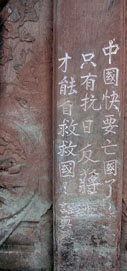
Landscape
Landscape
What can we learn from a cultural analysis of the village
landscape-the interwoven field of physical environment, moral agency,
and historical memory in which particular places gather and keep a
people's sense of themselves? This landscape approach gives priority to
villagers' conscious representations, analyses and understandings of
their relationship to place.
Changing government policies in China during the past century have been
a conscious effort to alter the relations of production. Thus any
portrait of how villagers today conceive of their relationship to the
land must refer to an indigenous account of the historical processes
through which this relationship has been formulated. Values and beliefs
concerning land and place are not static but part of a dynamic
interaction between people, policies and experiences. One can use the
notion of frameworks for understanding the overlapping and sometimes
contradictory understandings of place held by local people—both
as individuals and as a group. One framework is the historical
framework—things change over time and the place we see before us
now has seen great changes. Another framework is the framework of
economic development, arguably the dominant framework operating
today. In this framework, place is seen as a constellation of
resources which can be converted into earnings for local people or
outsiders and the struggle to make the most of them can easily dominate
life as it is lived. Closely related to economic development, is
the framework of environmental conservation. Because of the
fragility of the mountain ecosystem, the value of environmental
conservation has long been well known to all who live here.
Sometimes it has operated as a counter-point to economic development,
but is more usually seen as directly benefiting local people and is a
value the farmers as well as the local city-people identify with. Most
recently it has acted in tandem with economic development, as the
region works toward selling itself as the home of eco-tourism or green
products. Nevertheless, there is some tension as to who should bear the
costs associated with the tasks of economic development and
environmental conservation and whether the burden and benefits are
administered fairly or not. A fourth framework we explore
is what we can call the fengshui framework. The concepts of fengshui
(Chinese geomancy) are embraced by most people living in this place,
but the applications of fengshui go well beyond the esoteric knowledge
of geomancy as applied by Daoist experts. As we apply the term,
it would include everything from house design to the special magic of
rocks and trees and flood waters to the influence of historical events
on the location where they took place. It makes no sense to
try to truly disentangle these frameworks; in their application they
are intermingled.
The first essay spells out the way in which we first encountered
villagers engendering village space as a social metaphor—in the
context of interpersonal social conflicts and is a good place to begin
an understanding of fengshui. The next few essays expands the
idea of landscape as social metaphor to the more subtle and particular
aspects of the village environment—trees, soil, rivers,
rocks. The essays on ecotourism, ancient town, and new houses are
chronological histories detailing specific development efforts of the
past two decades that have explicitly aimed at radically changing local
people's relationship to place. The last essay clarifies the
theoretical aspects of our “landscape approach” in a
larger cross-cultural context.
Landscape Essays
- Social Conflict and its Spacial Dimension
- Trees
- Soil
- Rivers and Rocks
- Ecotourism
- Ancient Town
- New House
- Landscape: theoritcal approaches
